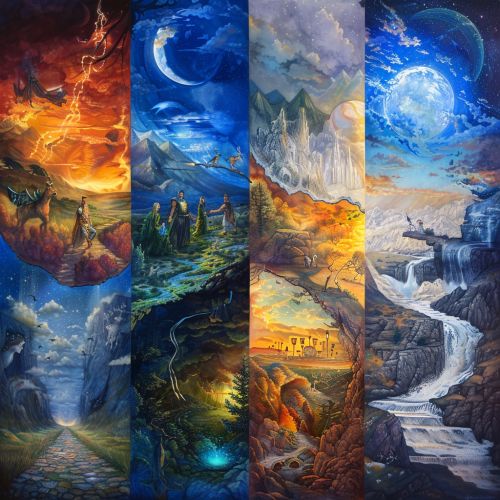The Hero with a Thousand Faces
Introduction
"The Hero with a Thousand Faces" is a seminal work of comparative mythology by Joseph Campbell. First published in 1949, the book explores the theory of the monomyth, or the "hero's journey," which Campbell argues is a universal pattern found in narratives from various cultures and epochs. The book has had a profound influence on both academic studies and popular storytelling, including literature, film, and psychology.
The Monomyth
The central thesis of "The Hero with a Thousand Faces" is the concept of the monomyth, a term borrowed from James Joyce's "Finnegans Wake." Campbell posits that many mythological narratives from disparate cultures share a fundamental structure, which he outlines in several stages. These stages can be grouped into three main acts: Departure, Initiation, and Return.
Departure
The Departure phase involves the hero leaving their ordinary world and venturing into the unknown. Key stages include:
- **The Call to Adventure**: The hero is invited to leave their mundane life and embark on a quest.
- **Refusal of the Call**: Initially, the hero may hesitate or refuse the call to adventure due to fear or obligation.
- **Supernatural Aid**: A mentor or guide, often possessing magical abilities, provides the hero with assistance.
- **The Crossing of the First Threshold**: The hero leaves the familiar world and enters the realm of adventure.
- **The Belly of the Whale**: The hero undergoes a transformative experience, symbolizing death and rebirth.
Initiation
The Initiation phase involves the hero's trials and tribulations in the new world. Key stages include:
- **The Road of Trials**: The hero faces a series of challenges that test their resolve and abilities.
- **The Meeting with the Goddess**: The hero encounters a powerful female figure who offers support or wisdom.
- **Woman as Temptress**: The hero faces temptations that may lead them astray from their quest.
- **Atonement with the Father**: The hero confronts and reconciles with a paternal figure, often representing authority or power.
- **Apotheosis**: The hero achieves a state of enlightenment or divine knowledge.
- **The Ultimate Boon**: The hero obtains the object or knowledge they sought, which often has the power to transform their world.
Return
The Return phase involves the hero's journey back to their ordinary world, transformed by their experiences. Key stages include:
- **Refusal of the Return**: The hero may be reluctant to return to their mundane life.
- **The Magic Flight**: The hero's return journey may be fraught with danger or pursuit.
- **Rescue from Without**: The hero may require assistance to return home.
- **The Crossing of the Return Threshold**: The hero re-enters their ordinary world, bringing with them the boon or knowledge they have acquired.
- **Master of Two Worlds**: The hero achieves a balance between the ordinary and extraordinary realms.
- **Freedom to Live**: The hero, having completed their journey, is free from fear and able to live fully.
Comparative Mythology
Campbell's work draws extensively from a wide range of mythological sources, including ancient Greek, Roman, Egyptian, Norse, and Hindu myths, as well as indigenous traditions from Africa, the Americas, and Oceania. By comparing these diverse narratives, Campbell identifies common themes and motifs, such as the hero's journey, the wise old man, and the sacred marriage.
Archetypes
Campbell's analysis is heavily influenced by the work of Carl Jung, particularly his concept of archetypes. Archetypes are universal symbols and motifs that recur across different cultures and time periods. Key archetypes in the hero's journey include:
- **The Hero**: The central figure who embarks on the quest.
- **The Mentor**: A wise and often supernatural guide who aids the hero.
- **The Threshold Guardian**: A figure or obstacle that the hero must overcome to enter the realm of adventure.
- **The Shadow**: The hero's antagonist, often representing their inner fears or desires.
- **The Trickster**: A mischievous figure who disrupts the hero's journey, often providing comic relief or challenging the hero's assumptions.
Influence and Legacy
"The Hero with a Thousand Faces" has had a significant impact on various fields, including literature, film, psychology, and religious studies. Its influence is particularly notable in the realm of storytelling and screenwriting.
Literature
Many authors have drawn upon Campbell's monomyth in crafting their narratives. Notable examples include J.R.R. Tolkien's "The Lord of the Rings" and J.K. Rowling's "Harry Potter" series. These works follow the structure of the hero's journey, with protagonists who undergo transformative quests.
Film
Campbell's ideas have also profoundly influenced the film industry. George Lucas, the creator of "Star Wars," has cited "The Hero with a Thousand Faces" as a major inspiration for the saga. The structure of the hero's journey is evident in the character arc of Luke Skywalker, who transitions from a farm boy to a Jedi Knight.


Psychology
In psychology, Campbell's work has been used to explore the role of myth in human development. The hero's journey is seen as a metaphor for personal growth and self-discovery. Psychologists such as James Hillman and Robert A. Johnson have incorporated Campbell's ideas into their therapeutic practices.
Religious Studies
Campbell's comparative approach has also influenced the study of religion. By identifying common patterns in myths from different cultures, Campbell's work supports the idea of a universal human experience underlying diverse religious traditions. His analysis of the hero's journey has been applied to the lives of religious figures such as Buddha, Jesus, and Mohammed.
Criticisms
While "The Hero with a Thousand Faces" has been widely acclaimed, it has also faced criticism. Some scholars argue that Campbell's monomyth oversimplifies complex narratives and imposes a Western framework on non-Western traditions. Others contend that Campbell's reliance on Jungian archetypes lacks empirical support and is overly speculative.
Conclusion
"The Hero with a Thousand Faces" remains a foundational text in the study of mythology and storytelling. Its exploration of the hero's journey has provided valuable insights into the universal patterns that shape human narratives. Despite criticisms, Campbell's work continues to inspire and inform a wide range of disciplines.
